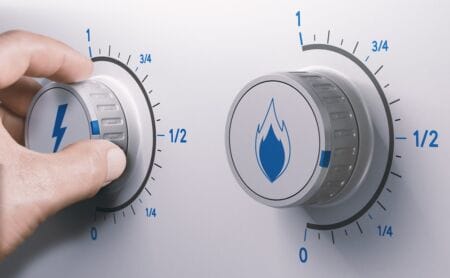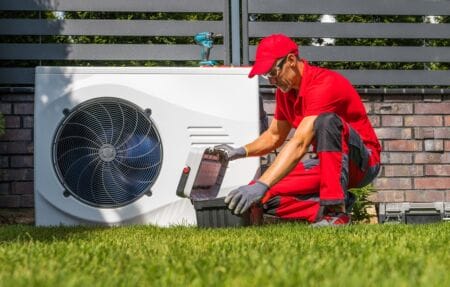Table of Contents
Contents
ToggleWhat we'll cover...
What radiator foil and radiator reflectors are, why to put tin foil behind radiators, and whether or not they are an effective and worthy investment to enhance your home heating setup.
What is radiator foil?
Radiator foil, also sometimes known as heat reflector foil, is a thin reflective sheet typically made from aluminium and backed by insulating material. It’s designed for positioning directly behind your radiator, ideally between it and an uninsulated wall, to bounce heat back into the room.
The concept is simple: instead of letting precious heat seep into your brickwork and unnecessarily boost the temperature of your neighbour’s hallway, the foil acts as a thermal bouncer. It reflects radiant heat back where it belongs – your living space.

What is radiator foil used for?
The main purpose of radiator foil is to enhance the efficiency of your heating system by reducing heat loss. Designer radiators don’t just emit heat into the room – they also emit it backwards into the wall behind them. If that wall is an uninsulated external wall, a fair amount of warmth will be wasted.
By placing radiator foil behind the radiator, you bounce that heat back into the room. This can:
- Make your home warmer, faster
- Slightly reduce energy consumption levels
- Lower your heating bills over time
- Make your heating system feel a touch more responsive
So, the principle is solid. But does it work?
The efficacy of radiator foil and reflectors
Let’s get down to brass tacks (or in the specific case of radiator reflectors, foil-backed polyester).
So, does putting foil behind radiators work?
In short, the answer is yes, but context is key.
Radiator foil can reduce heat loss through walls by up to an impressive 54% in certain setups, according to the Energy Saving Trust. However, the actual total energy saving figure is far more modest. A study by the University of Salford found that reflective foil could save around 2.9% of space heating gas consumption on a typical UK winter day, depending on insulation and radiator position.
Anecdotally, many homeowners do notice a difference, especially in rooms with:
- Older external walls
- Radiators positioned on solid, uninsulated surfaces
- Smaller heating setups that rely on maximum output from every radiator
If your radiator is situated on an uninsulated external wall, you should definitely think about the addition of radiator foil. It’s cheap, simple, and can effectively reduce heat loss in specific setups. If your home is already well-insulated, the benefit may be minimal in comparison.
You’ll notice in the likes of forum discussions and Reddit threads that plenty of people believe in the benefits of radiator reflector panels and foil if used in the correct setting. But let’s be clear: foil alone won’t revolutionise your heating bill. Think of it as an important part of a bigger energy efficient heating jigsaw.
What affects the efficiency of radiator foil?
Radiator foil isn’t a silver bullet (even if the colour scheme checks out). It works best when the conditions are suitable. Here are the key factors to consider:
Radiator type
Certain radiator designs will lend themselves better to reflective backing:
- YES – Panel and convector radiators (the most common types) emit heat directly backwards, making them ideal candidates for foil lining.
- NO – Column radiators (especially cast iron radiators) emit heat 360°, so less heat is lost from the back, making foil less effective.
- MAYBE – Designer radiators with odd shapes or open backs may not allow foil to sit properly behind them. Some designs will be more conducive to a successful radiator foil performance.
If your radiator is pumping heat mostly forwards or upwards, foil won’t intercept much or therefore make much of a difference.
Placement
Location is vital. Radiator foil is most effective when positioned behind radiators mounted on external walls, particularly those with:
- No cavity wall insulation
- Solid brick or stone construction
- North-facing exposure (where heat loss is usually highest)
If your radiator is installed on an internal wall, or the wall behind it is well insulated to begin with, the impact will be much smaller.
Foil quality
Perhaps obvious, but there’s a huge difference between purpose-built radiator foil and a sheet of kitchen tinfoil taped behind a radiator:
|
Type |
Pros |
Cons |
|
Radiator-specific foil |
Reflective, backed with insulation, cut to fit |
Slightly more expensive |
|
Insulation board + foil |
Very efficient, adds extra barrier |
Thicker and not always practical |
|
Kitchen foil |
Cheap, accessible |
Fragile, less reflective, crinkles like a crisp packet under stress |
Pro tip: If you do use tinfoil as a budgetary stopgap, at least tape it to a piece of card or foam board first for extra rigidity and effectiveness.
1. Bleed and balance your radiators
Trapped air and unbalanced systems reduce heat output. Our guide on how to bleed a radiator can assist.
2. Use a BTU calculator
Make sure your radiator is big enough for the space. Use our BTU Calculator to assess.
3. Don't block the heat
Move furniture away, avoid long curtains over the top, and fit a shelf above to deflect warm air into the room.
4. Fit TRVs (thermostatic radiator valves)
Thermostatic radiator valves allow you to control temperature on a room-by-room basis, as opposed to heating each area to the same level.
5. Insulate behind your radiator
If you’re commencing with deeper renovation work, insulated plasterboard with foil backing offers a bigger long-term gain.
6. Consider radiator upgrades
Newer radiator designs and materials are far more efficient. Read our guide, is it time to replace your radiators?
7. Make your home more energy efficient overall
From loft insulation to draft-proofing, there’s plenty of ways to enhance the energy efficiency levels of a home away from the most obvious means such as the addition of electric radiators and the like.
Enhanced heating efficiency with BestHeating
If your walls are uninsulated, your heating bills are creeping up, and your radiator sits against a chilly exterior wall, adding foil is a smart little low-cost upgrade. It’s not flashy. It won’t save you hundreds overnight. But it’s a practical, budget-friendly move that stacks up well in combination with other heating improvements.
Explore a range of energy efficient heating solutions from BestHeating, and let us know about your own heating hacks and upgrades in the comments, or via Instagram, Facebook or X.
John is a Research Specialist for the Best Heating Advice Centre, where for over nine years he has dedicated himself to demystifying home heating for our customers. He specialises in creating clear, data-driven guides and how-to articles by collaborating directly with our team of certified heating experts and product engineers.
His work, built on a foundation of journalistic research, has helped millions of readers make confident and informed decisions about their home heating. When he’s not breaking down the heat output differentials from radiators to heated towel rails, John fancies himself as a fine football and music connoisseur.







